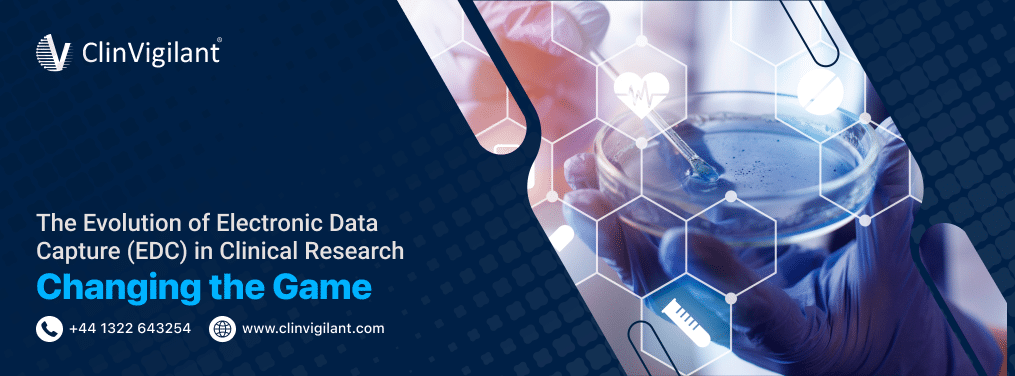
Nowadays, EDCs have become seamlessly compatible with various software in the eClinical field, making data transfer a breeze. It has become a typical practice to effortlessly import electronic data from external sources like imaging data sources, lab reports, and electronic health records into an EDC. Moreover, the rising trend of open-source EDC software and independent data standards (such as CDISC) is playing a significant role in boosting productivity.
Keeping up with the ever-evolving landscape of data capture in clinical trials can be challenging amidst the increasing chatter surrounding the latest clinical trial tools. However, this comprehensive guide aims to provide you with valuable insights on Electronic Data Capture (EDC).
What Does Electronic Data Capture Mean?
Electronic Data Capture In Clinical Trials is the use of specific software to collect, clean, send, work with, and store data in clinical studies. Contract Research Organizations (CROs), sponsors, and trial locations use these systems a lot. Their use goes from easy to complicated studies. By choosing to keep records digitally, those running trials get rid of the need for old-fashioned paper collecting data. Doing this allows safe data capture, makes the study process quicker, and makes certain important information can be used again.
Now, many EDC In Clinical Trials systems are in the cloud. This lets users safely get into them from any place. These systems gather different kinds of data depending on the therapeutic area associated with the clinical trial. For instance, in an oncology study, the data forms utilized could encompass:
Here are some key details that are collected during medical research studies:
- Adverse Events: It is closely monitored, and any negative occurrences that may happen during the study.
- Biochemistry: Various chemicals are analyzed, as well as the substances in the body, to understand their impact on health.
- Coagulation Tests: Coagulation tests are done to assess blood clotting ability to better understand potential risks.
- Concomitant Medication: Recording of any other medications participants are taking along with the study treatment.
- Death information: It is essential to gather details if unfortunate events occur during the study.
- Demographics: Collection of information about participants’ backgrounds, such as age, gender, and ethnicity, to ensure diverse representation.
- ECOG Performance Status: It is essential to evaluate the physical and functional abilities of participants based on Eastern Cooperative Oncology Group (ECOG) criteria.
- Hematology: Examination of blood components and function to gain insights into overall health.
- Medical History: Gathering past medical information to better understand participants’ health backgrounds.
- Tumor Assessments: Closely monitor and evaluate tumor growth, characteristics, and response to treatment.
- Treatment Data: Tracking and analyzing specific details regarding the treatment participants receive.
- Survival Follow-up: Conduct regular assessments to track participants’ survival rates and duration.
- Urinalysis: Examination of urine samples to identify potential health markers.
- Vital Signs: Measure fundamental indicators like blood pressure, heart rate, and body temperature to assess overall well-being.
Why EDCs are Great for Clinical Trials
Clinical trials might feel tough. They need a lot of time, money, and effort from people in them. But there’s help! Electronic Data Capture (EDC) is here. EDC In Clinical Research helps trial sponsors make every part of research better and faster. So, it’s quicker to market, there’s less risk, and people in trials are happier.
Plus, it’s not costly. Take a break and let EDC In Clinical Trials handle your clinical trial work. With Electronic Data Capture systems (EDCs), trial sponsors can make clinical trials that meet what regulators, payers, and people in them need. By employing a versatile and interoperable foundational data platform, researchers can expedite their research and, at the same time, reduce expenses.
Benefits of EDC in Clinical Trials
- Include the Gathering of Real-World Data (RWD)
The data collection phase is done, and statistical processing becomes quick and efficient. The EDC In Clinical Trials system supports RWD collection through various means:
- It ensures that the data being collected is accurate and appropriate by having built-in plausibility checks.
- Researchers can enable remote patient participation, making it easier for patients to contribute their data.
- Best EDC Software In Clinical Research allows researchers to set constraints on forms, preventing the entry of inaccurate or illogical values.
- Source data verification and edit checks are supported, ensuring that the collected data meets the required ranges and formats before being accepted into the trial database.
- By reducing the need for paperwork, the eClinical Solution In Clinical Trials saves time on data entry.
Incorporating the use of an Electronic Data Capture In Clinical Trials can greatly support the collection of RWD by ensuring data accuracy, providing remote patient participation, preventing the entry of invalid values, verifying data sources, and reducing data entry time.
- Facilitating Global Data Collection
In the realm of clinical trials, it is common for participants and researchers to be scattered across the globe. Electronic Data Capture In Clinical Trials plays a vital role in ensuring accuracy in international clinical studies through various features such as readable entries and automatic calculations. The significance of EDCs in supporting global clinical trials can be summarized as follows:
- Enabling data entry and accessibility at any location and time.
- Implementing medical coding protocols to code all symptoms and disease names according to internationally recognized terminology.
- Identifying and resolving data discrepancies at remote sites through the utilization of digital tools.
- Empowering data managers to conveniently review information and promptly communicate queries to sites to resolve any inconsistencies.
- Detecting and rectifying uncertain data by employing numerical data validation techniques.
- Embracing the inherent capabilities of EDC In Clinical Trials truly simplifies the process of capturing and managing global data in clinical trials.
- Automating Trial Designs for the Next Generation
The era of laborious manual data entry is long gone. Clinical trials now rely on automation to expedite research and enhance the return on investment. Implementing automation in Best EDC Software In Clinical Research brings several benefits to researchers, including:
- Facilitating remote monitoring processes not only improves efficiency but also significantly cuts costs.
- Enabling market authorization to occur with the utmost speed.
- Enhancing trial efficiency and productivity, resulting in a further reduction in overall clinical trial expenses.
- Streamlining collaboration workflows
Throughout various stages of studies, trial teams, monitors, and auditors require the ability to capture, process, and retrieve data from any location and at any given time. EDC In Clinical Research enables the swift sharing of data among relevant personnel, facilitating seamless information exchange by:
- Facilitating real-time data access while minimizing query management time.
- Granting authorized individuals the flexibility to retrieve, download, and generate status reports at their convenience.
- Supporting informed decision-making and adaptive trial designs through easy access to data insights.
- Providing search functionalities that enable users to effortlessly locate and filter the specific information they seek.
- Centralizing all data in one accessible location, ensuring enhanced visibility.
- Connecting data collected in one eClinical Solution In Clinical Trials to another for comprehensive analysis.
- Collecting only the necessary data required for a particular patient’s circumstances at a specific moment.
- Effortlessly manage changes during the study
EDC In Clinical Trials offers flexibility and adaptability to cater to the evolving requirements of the study. They facilitate mid-study changes through the following:
- Promptly receiving feedback from study monitors and participants.
- Allowing protocol amendments during the study.
- Instantly updating electronic Case Report Forms (eCRFs) across all sites of a multi-site or multi-continent study.
- Leveraging data traceability and access controls.
- Utilizing designated permissions with specific roles executing most actions, thereby ensuring data security efficiently.
What Qualities Should you Consider When Investing in an EDC?
While purchasing a sturdy EDC In Clinical Research may require a significant investment, the long-term cost savings make it a worthwhile expense. Here are the key factors to consider:
- An intuitive interface that facilitates collaboration among multiple sites and researchers on a global scale.
- The availability of automated checks and data limits to minimize errors.
- Assurance of compliance with privacy and data protection regulations.
- Seamless integration with existing tools, such as wearables or legacy systems.
- The ability to reuse trial data for future purposes.
- Technical advisors who can assist with setup and provide guidance at every stage.
- An eCRF designer that offers reusable templates and includes built-in edit checks.
- A combination of auto-generated and manual queries.
- Built-in metrics reporting to gain valuable insights throughout the study.
Conclusion
The utilization of Electronic Data Capture (EDC) has unquestionably revolutionized the field of clinical research. EDC’s capacity to optimize efficiency, guarantee data integrity, and promote collaborative efforts has positioned it as an essential component of contemporary clinical trials.
Although there are inherent challenges, ongoing advancements, and innovations hold the promise of addressing these obstacles and taking the capabilities of EDC systems to greater heights. As we contemplate the future, the integration of technology and data-focused methodologies will undeniably shape the landscape of clinical research, laying the foundation for more impactful and ground-breaking medical advancements.

